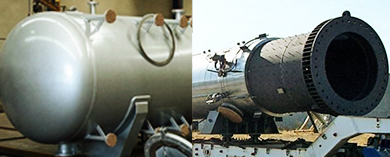
- (03) 5909 8218
- enquiry@fusionweld.com.au
Defining the Purpose of Reactor and Regenerator
February 12, 2015

We've trailed circulating vapours and fluids as they separate from crude oil, observing their path through the numerous stages of the hydrocarbon refinement process. Splitting oil into aviation fuel, plain gasoline, viscous asphalt, and any other imaginable oil by-product, tangles of metal pipes and vessels incorporate innovative new means of distilling this black gold, but some methodologies hold firm. The fluid catalytic cracking unit (FCCU), a means of instigating a dynamic chemical reaction, has been part of the oil and gas refinery environment since the 1940s. Within that unit, several core agitation sections, vessels and risers, form the basis of the FCCU.
A primitive description of long chain hydrocarbon cracking assigns an internal primary reactor as the sealed processing unit. This key part of the catalytic operation breaks the long chains into smaller molecules, the oil-derived products that find their ways into common fuels and plastics. Meanwhile, the regenerator section takes the remnants of the process and recycles the components, simultaneously cleaning out the leftovers of the catalyst. Air and steam blend with the vapours left from the oil to drive this cycle round and round, leaving us with big clues on the heat and chemical resistance factors required for both vessels. As stated, this is a simplistic description. Practical FCCU sections integrate combustion air stages and conduits for adding the catalyst in a pellet form. The pipes and vessels are optimized to function through risers and distillation columns, with the final stage shaped by the fractionating section. Still, it's the design considerations of the reactor and regenerator vessels that concern us today, so let's take a closer look at this dual configuration.
Preheated to approximately 430°C and maintained at one atmospheric pressure, the petroleum feed is a caustic fluid dominated by a catalytic environment where metal-fatiguing molecular reactions are the norm. Cyclonic action adds yet another challenging force to the mix, as motion dynamically separates the catalyst at the end of the cycle. To add insult to injury, there's also a mass of slurry and a crust of coke formed by the heat. These temperatures quickly rise to over 700°C, meaning vessel designers must provide a reinforced fabrication ethic, one that combats sulfidic corrosion and heat damage. Cutting-edge alloys are used to back this ideal manufacturing goal, as is strengthened welding overlays.
In the pioneering days of the past, the internal structure of an early reactor vessel had little chance of resisting the abrasive forces introduced by catalytic reactions, the corroding influences of heat and pressure. It was common to approach the issue as if this was a furnace, lining the interior of the chamber with bricks. Today's reactors and regenerator cores use specialized alloys, opting for monolithic fabrication techniques to eliminate weak areas introduced by weld points. The extraction of high-quality petroleum products depends on this efficient lining design to keep the catalytic process moving.
Contact Details
Fusion - Weld Engineering Pty Ltd
ABN 98 068 987619
1865 Frankston Flinders Road,
Hastings, VIC 3915
Ph: (03) 5909 8218
Optimized by NetwizardSEO.com.au
Recent Posts
- Compressed Hydrogen Storage Vessels: Material Selection, Design & Australian Standards
- Welding QA/QC in Oil & Gas Pressure Vessel Fabrication – Ensuring Code Compliance
- AS1210 vs ASME VIII Pressure Vessel Code: Key Differences for Australian Projects
- Mitigating Hydrogen-Induced Cracking in Pressure Vessels: Engineering and Material Strategies
- Storage Tank Solutions Australia: Field-Erected, Prefabricated & Self-Bunded Explained
- Reducing Environmental Risks: Self-Bunded Tanks in Australian Oil & Gas Operations
- Precision in Production: How Pressure Vessels Are Manufactured for Industrial Safety
- Shell & Tube Heat Exchangers: Improve Thermal Control & Energy Recovery in Petrochemical & Pharmaceutical Plants
- In-Service Inspection for Compressed Air Receivers for Power Plant Shutdown Prevention
- Power Plant Pipe Spooling Fabrication – Get Rapid, Code-Compliant Spools Ready for Installation
- Field Erected Tanks: Safe, Reliable On-Site Fuel Storage Solutions in Australia
- Custom Pressure Vessel Fabrication for Flammable Gases
Posts 2025
- Compressed Hydrogen Storage Vessels: Material Selection, Design & Australian Standards
- Welding QA/QC in Oil & Gas Pressure Vessel Fabrication – Ensuring Code Compliance
- View all articles…
Posts 2024
- Large Process Vessels: Optimising the Design for Maximum Efficiency [2025]
- Pressure Equipment Management System Installation: Detect Equipment Faults Early
- View all articles…
Posts 2023
- Pressure Piping System Inspection: A Gift of Safety for the Holidays
- Deaerator Inspections by Fusion-Weld Engineering and How They Reduce System Downtime
- View all articles…
Posts 2022
- How Fusion Weld Keeps Up With AS-NZS ISO 9001:2008 Standard
- Boiler Equipment Safety Inspection During the Summer Season
- View all articles…
Posts 2021
- Avoid These Factors and Practices that Contribute to Sealing Damage in Pressure Vessels
- Do's And Don'ts Of Industrial Boiler Inspection And Maintenance From Fusion-Weld
- View all articles…
Posts 2020
- What are the Risks and Hazards Involved in Pressure Vessel Equipment?
- How to Know if Your Pressure Equipment Needs Repair or Replacement?
- View all articles…
Posts 2019
- Factors that Contribute to Pressure Vessel Failure
- Pressure Vessel Regulations in Australia: What are the Mandatory Requirements?
- View all articles…
Posts 2018
- Pros and Cons of Spherical vs. Cylindrical Pressure Vessels
- What are the Different Hazard Levels in Pressure Vessels?
- View all articles…
Posts 2017
- Transportable Pressure Vessels: The Importance of Inspection and Safety Checks
- Fracture Mechanics and Stress Analysis of Cracks in Pressure Vessels
- View all articles…
Posts 2016
Posts 2015
- What Are Deaerators & Feedwater Vessels?
- Precautions and Safety for Compressed Air Receiver Vessels
- View all articles…
Posts 2014
- Demonstrating In-process Inspection Procedures
- Static Grounding Practices and Standards
- View all articles…